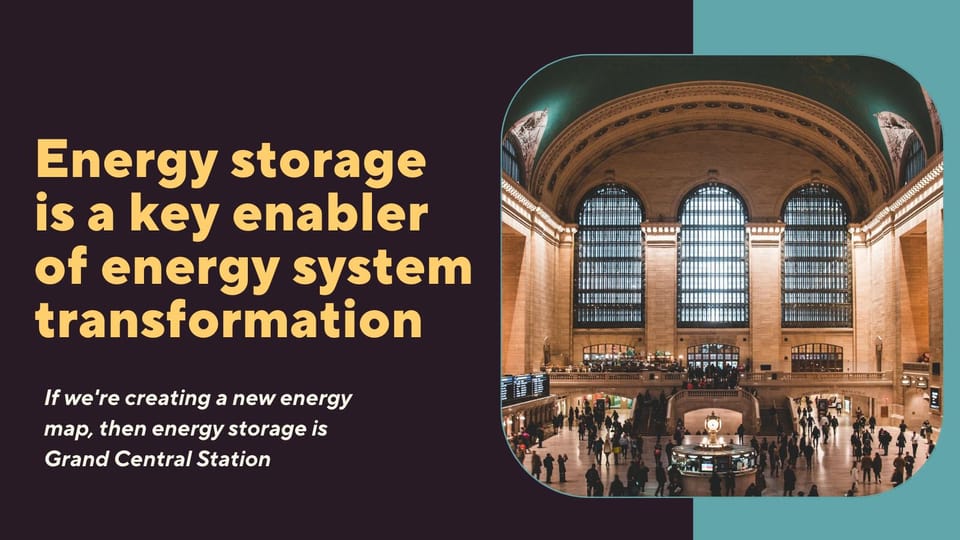Why energy storage is key to system transformation

As Ireland and Europe create a new energy map, storage will play a key role. To continue the map analogy, we can think of energy storage as the grand central stations of a tube map. Sure, they’re a destination station but they’re more than that – they enable transfers from local to regional lines and sometimes even international journeys.
In addition, energy storage provides a good way to interrogate energy system transformations by considering its role in Decarbonisation, Decentralisation, Digitalisation, and Democratisation, also known as the four Ds, because us energy nerds love a bit of alliteration.
Decarbonisation
Following energy demand reduction, using renewable electricity is the top action for decarbonising our energy system. Electricity systems are based on a supply being connected to a demand, so if these happen at different times, then the ability energy storage is key because it balances out supply and demand. On calm windless evenings, the stored energy can power our grid. Then on super windy days, we can store energy so as not to waste the resource nor leave expensive infrastructure lying idle.
Decentralisation
The robustness of an energy system is enhanced through decentralisation. We’ve all experienced the unwelcome interruption to our electricity supply in our homes. This can be so intolerable to some that they’ve created their own discrete decentralised solutions through diesel generators or natural gas-powered electricity generation on site. Decarbonised solutions will be required to meet this security of supply need. For example, as drivers move towards electric vehicles, not only will they have emissions free driving, but their car could serve as a backup energy store for their domestic electricity needs.
On a more regional level though we can introduce local energy storage solutions, like batteries to kick in when there is an outage on the system.
Digitalisation
We are going to need oodles of data to enable the smart and complex choices we needed for an integrated energy system. We’re going to need to know what type of electricity is available through domestic production and interconnection, how sustainable it is and how much it costs. However, if we really want to maximise this availability of data, we need to be able to act on it to maximise renewables and minimise cost – that’s where the ability to integrate energy storage into a system is key. Such energy storage creates buffers between supply and demand so that we can maximise the benefits of a complex and integrated energy system.
Democratisation
For Ireland to have a green independent energy future, we need to have indigenous stores of energy. For democracy to thrive, we cannot continue to rely on imported fossil fuels. Our reliance on importing oil, coal and gas means countries like Russia will continue to benefit them financially. By storing energy, Ireland will be able to attract foreign direct investment by large energy companies who are enticed by the economic carrot of the amount of energy available and not the domestic need. Storing energy is key to being able to then export it, for Ireland could become a source of energy for countries who are importing carbon-based fuels today and look to a future energy system of zero carbon fuels. Ireland’s role in a future energy system as a democratic energy exporter also avoids a new form of colonialism where countries are prevented from developing because of the attractive payment schedules of sending their energy to already developed economies. Furthermore, by storing energy, we can increase the amount of renewable energy supply chain jobs in Ireland, as high as 25000 by 2040 according to the SEAI reports.
Types of Energy Storage and the need for development
When it comes to energy storage, there is no one size fits all. We need batteries to meet the shorter-term needs such as for electric vehicles, homes or even for hours on the national grid. While we have familiarity with batteries, there is much research and development needed to address their limitations. For example, the precious metals used in their creation are not always recoverable and given the limited access to Lithium and the like, there are associated supply chain issues. Extraction of such metals comes at an environmental cost as does shipping them from their countries of origin to where manufacturing takes place. Research is needed to figure out how to recycle such batteries or develop alternative chemical solutions.
Today, we’re meeting our energy storage needs through storing energy as molecules, with the national oil reserve agency keeping a supply available for 90 days of needs. Our wind powered electricity could be used for electrolysis to separate the hydrogen from oxygen in water. That hydrogen could be stored in underground geological structures – such as depleted gas fields or salt caverns. The plan for Europe is to have a dedicated hydrogen pipeline, which offers storage in the same way that natural gas pipelines do today.
Like all aspects of energy system transformation, there is no easy answer. We need all the solutions progressed in parallel. The energy system of the future must be decarbonised, distributed, digitised and democratic and one thing’s for certain, energy storage will be key.